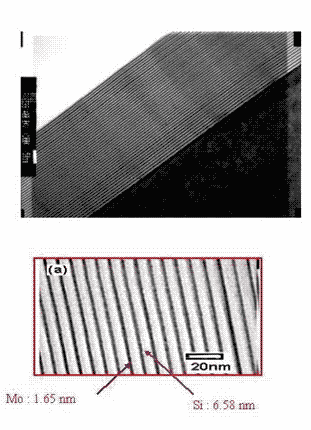| During the past two decades,
tremendous efforts have been made to develop more brilliant,
stronger light source in the extreme ultraviolet(EUV) ( 100 - 0.3
nm) and x-ray ( 0.3 - 0.01 nm) spectral region. The development and
construction of the 3rd generation of synchrotron light facility and
the development of X-ray lasers around the world are the fruits of
such efforts. Nowadays many areas of science and technology benefits
from such development. For the better usage and manipulation of such
light sources, the high quality of optics in the spectral region
must be provided. In the extreme ultraviolet ( 100 - 0.3 nm) and
x-ray ( 0.3 - 0.01 nm) spectral region, the index of refraction of
most of material is very close to unity. Most of materials are good
absorbers of the EUV light. Hence the lenses can not be used at all.
Traditionally focusing has been done by mirrors coated with high Z
elements. |
 |
|

Mo/Si Multilayer
x-ray mirror
fabricated for 18.2 nm
light
|
However since the
index of refraction is very close to unity, the reflection off a
well-polished metal surface at normal incidence is also very small (
order of 10-5-10-4). The reflection optics have been used at grazing
incidence angle, despite of the distortion of image quality. The
improvement of image quality requires optics with high reflectivity
at normal incidence.
How do we achieve
this? People has adopted the idea of quarter wave plate from optics
or equivalently the idea of Bragg reflection off atomic planes in a
crystal. Consider an artificially-made multilayer structure as shown
in the above figure where the thickness of each layer is of the
order of the wavelength of light under interest (since we are
dealing with EUV lights, the thicknesses of layers are of a few
nanometers ). The lights are reflected off each interface, even
though small, and the reflected lights interfere. But if they are in
phase at a certain direction, the intensity at that particular
direction will be significant (This is basically Bragg condition of
X-ray scattering by atomic planes in a crystal). In fact, the
intensity can be increased a few hundreds to thousand times. Hence
the performance of multilayer x-ray optics is strongly dependent on
the wavelength under usage, the structure of the multilayer system
(layer thickness, materials used, and the number of layers, etc.)
and the anlge of incidence. The multilayer x-ray optics has to be
designed for the specific purpose in mind.
|
further readings and related works
during the past years, Dong
Eon Kim's group has done the following investigations with respect to
multilayer x-ray optics:
"First
stage in the development of a reflection imaging x-ray microscope in
schwarzchild configuration using a soft x-ray laser at 18.22 nm", Opt.
Lett. 17, 157 (1992).
"Mo-Si multilayer as soft x-ray mirrors for the wavelengths
around 20 nm region", J. Vac. Sci. Technol. A 12, 148
(1994).
"structural analysis of Mo-Si multilayered x-ray mirror
by x-ray diffraction," J. Korean Phys. Soc. 29 (1), 74 (1996).
"Structural characterization of a Mo/Si multilayer
reflector by means of x-ray diffraction measurement," J. Vac. Sci.
Technol. A 154, 2291 (1997).
"Optimized structures of multilayer
soft x-ray reflectors in the spectral range of 30 to 300 A," Japanese
Journal of Applied Physics 37, 2728 (1998).
"Nonspecular x-ray reflectivity of partially correlated
interface roughness of a Mo/Si multilayer," Phys. Rev. B 57 (15), 8786
(1998).
"Characterization of a multilayer soft x-ray reflector
fabricated by pulsed laser deposition," Appl. Suf. Sci. 127-129, 531
(1998).
"transmission characteristics of multilayer structure in
the soft x-ray spectral region and its application to the design of
quarter-wave plates at 13 and 4.4nm," J. Vac. Sci. Tech. A. 17, 398
(1999).
"Normal-incidence pulsed-laser deposition: better method
for fabrication of multilayer structures," Appl physics A 70, 235 (2000)
|

